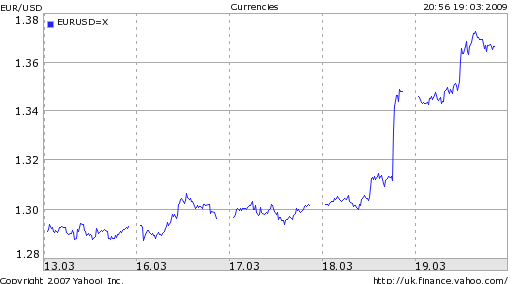March 19th 2009
Fed Turns on Printing Presses, Dollar Crashes
Having already lowered interest rates essentially to zero, the Fed has announced that it will now focus on ‘quantitative easing,’ a fancy way of saying that it intends to turn on the printing presses. It will purchase over $1 Trillion in credit instruments, split between Treasury securities and Mortgage-backed debt, expanding its balance sheet to $3 Trillion. This should (temporarily) put an end to speculation over whether foreign Central Banks are still willing to finance the US debt, as this question is now moot, since the Fed has demonstrated its willingness to fulfill that role. “The Fed is basically financing our deficit by buying the debt issued by the Treasury. If the Obama administration pushes through another stimulus package, the dollar is done.”
When the news was announced, the Dollar plummeted by 2.7%, the highest daily margin since 1971, as traders mulled the inflationary implications of printing over $1 Trillion and injecting it directly into the money supply, with the potential of more to come. Wrote one analyst, “Interest rates now are effectively negative across the board. The dollar is selling off because this may contribute to long-term weakness in the currency.”

Unfortunately for the Fed and the Dollar, the last few weeks have witnessed a slight pickup in risk tolerance, as investors began to focus more on fundamentals. If this development took place in the deepest chasm of the credit crisis, investors might have been willing to look the other way, but now they are very concerned that a huge expansion of the US monetary supply could trigger long-term inflation. A less pessimistic way of looking at the Dollar sell-off would be to attribute it to investor confidence that the Fed plan will help revive the global economy, decreasing the appeal of the US as a safe haven for investing.
Whether this will push the Dollar down further towards the $1.40 range depends on a couple factors. First of all, will other Central Banks follow suit? “All the major central banks may end up in the same position. The way we look to play it is to see which goes the first and which one lags, and try to explore the timing difference between the two,” explained one analyst. If this proves to be the case, investors will once again focus on the “least worst” currency, in which case the Dollar could once again come out on top.
It also depends on whether this action is intended as a quick fix, or as part of a series of purchases by the Fed. “Sell the dollar!” said…a portfolio manager. “This is huge, huge. It’s equivalent to the Plaza accord. This is the last thing theyhave in the closet, and they used it a bit early.”




March 20th, 2009 at 10:11 am
Switzerland has already started printing more of their currency, which has started some grumbling across Europe. But, really, I don’t suppose our government took a step like this without assessing the probability of other major countries following suit. Look for the GBP to come along in the not too distant future and, very likely, the Euro won’t be too too far behind.
April 11th, 2009 at 12:35 am
i think printing more money is like what switzerland is doing and i think march 2011 will tell